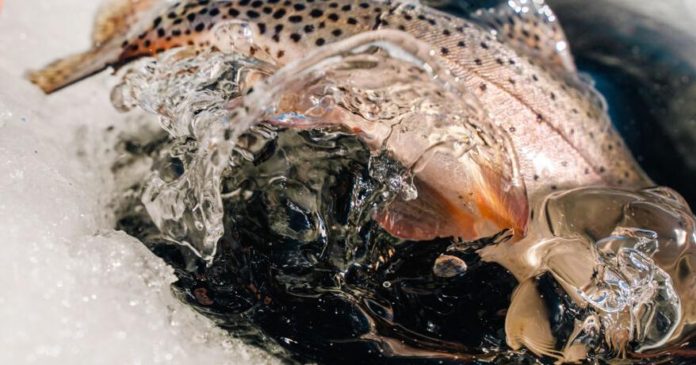Ice fishing is rising in popularity as a new favorite winter sport in the Valley.
Marty Voller likes to be on the ice by first light, which in the winter means around 6:30 a.m. That’s when he starts drilling with his hand-crank ice auger, penetrating through at least six inches of frozen lake water. After a hole is made, he settles back with an ice rod and spends the day hoping for a pull on his line. “I do it just to be out there,” he says. “I love being outdoors. Some people love skiing in the winter, but I love fishing.”
The Minnesota native has been year-round fishing since he was a child and doing it during the winter on Roaring Fork Valley lakes for at least 30 years. “In the early ’90s, you’d see one or two guys out there,”
says Voller. “Now on Ruedi [Reservoir], there can be 150 people fishing on any given day.”
Ice fishing—fishing through drilled holes on frozen lakes—has seen a local surge in recent years. Fishermen say the reason for that is multifaceted: It was a safe outdoor sport during Covid; it offers a winter alternative to skiing; and, the oft-culprit Instagram has made it popular as more people post about their adventures. “It’s really fun,” says Christian Hill, a local fisherman and fly-fishing guide with Taylor Creek Fly Shop.
“People think it’s a boring, nerdy, old-people sport, but when you’re out there with your community, bringing a barbecue or radio or whatever you want, you’re not just sitting on a bucket. Once you feel a tug of life on the other side of the line, people are hooked.” Pun unintended.
Ice fishing is a grassroots, community-driven sport. None of the local guide services offer regular ice-fishing trips. Instead, it’s up to curious anglers to learn from more experienced ones. Safety is paramount because—for obvious reasons—fishing on ice is inherently dangerous if someone doesn’t know how to read and maneuver the conditions. “We’re out there with life jackets and rescue ropes,” says Voller, who notes that he’s seen newbies engage in dangerous behavior, such as treading on weak ice.
Matthew Josephson, another Minnesotan who now lives in the Valley, says tracking ice development is part of the process. “You don’t just sit on a bucket and drink beer,” he says. “I work with the weather and freezing patterns.” This means making sure the ice is thick enough to hold a human, which typically means it’s approximately six-inches deep. To withstand snowmobiles, which anglers will sometimes use to access backcountry lakes, the ice must be even thicker. Most of the lakes popular for ice fishing—Ruedi, Harvey Gap, Rifle Gap and Chapman—freeze in late fall and stay frozen until late winter.
Fish live under the solid ice during the winter, often getting more sluggish as the water cools, so finding the spot where the fish are hanging out is part of the skill. Some will use sonar—aka “fish-finders”—to “see” what’s under the ice. In this area, the majority of fish in the lakes are various kinds of trout, and most people catch and release them. “I like the change from the other fishing I do,” says Hill. “When you get out there, it’s a complete mystery as to what’s on the other end. You could hook something insane. You never know what’s going to happen.”
For ice-fishing enthusiasts, that unknown—combined with time spent outdoors—seems to be the whole catch.
Credit: Source link






























